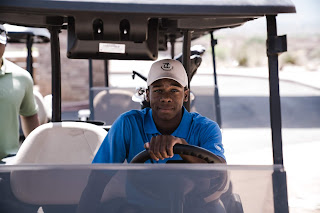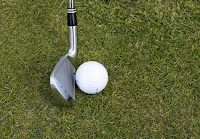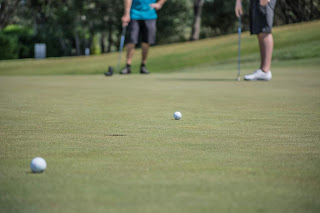So, where do we start?
Let us start with the END IN MIND:
Phase 5 - Bring your score home
Yes, there are many reasons to go out and play golf: enjoy nature, connect with friends, get your mind off every-day life, exercise, hit a good shot or two (or three), the atmosphere of the country club and so on.
Still,
if golfers are honest, the greatest joy in golf is tied to numbers - to our score.
But, what is a low score? For us amateurs, let us choose even PAR as a relatively objective indicator of solid golf.
And how do we shoot PAR?
Asking that would be like asking “How do you bring the horsepower of a car onto the road?” There are too many possible answers to point at only one thing.
So again, for our purposes, and starting with the end in mind, let us go with the following:
To score PAR, you must be able to bring your score home.
Let me explain:
Playing PAR or birdie once, or even twice, is NOT enough to play PAR on 18 holes. To bring our score home we want to stay out of trouble and, on top of that, be able to capitalize on the good shots we make hole by hole.
It sounds easier than it is!
Try playing two PARs or two birdies in a row and see how your mind and your heart start racing in excitement - excitement that distracts and gets you off course.
Getting the score home has a lot to do with curbing our enthusiasm and staying focused. And this plays into our cards on the green as well. Putting is mostly mental. In conclusion, you will sink those PAR-saving putts and birdie chances more likely than not, once you can get your excitement out of the way.
(As we break down this logic, we will see that the mental part of the golf game is not always essential. When you don’t have the mechanics of chipping and pitching down, for example, you can be in peak state all you want, it will not help!)
Let’s move on!
What brings the score home?
Let us go another step backward keeping the end in mind. What are we building on, when we are bringing our score home?
“Great ball striking!” you might be thinking.
Close, but not quite there.
There is an intermediate step. What if you have excellent ball striking skills that play the ball into the water or out of bounds?
Good ball striking and playing good shots are two different things in golf. Not every good shot comes from good ball striking and not every good ball strike is a good shot.
Phase 4 - Master the golf course
To bring your score home you must learn to master the golf course.
This is phase four.
Golf courses are designed - with hazards, yardages, out of bounds and downright traps. Anyone can learn to play straight shots on the driving range. Yet managing to bring these skills on to the golf course is a skill per se.
Mastering the course means to know your own game and to play it according to the conditions of the course and the weather; it means to calculate risk reasonably; to have multiple ideas to play one shot; to have options with the clubs available.
As far as I can tell this is all about experience. In this phase, we transition from WORKING golf to PLAYING golf. Until here, the golf swing is very much in our head. But from here, we are to play freely and spontaneously.
So, this was phase number 4. Let us think a step back again and ask the following questions with the end in mind.
Where does mastering the golf course come from?
What enables us to get this good, that we can play the course, instead of the course playing us?
In other words:
When do we have free capacities to put our focus on mastering the course?
It all relies on the earlier phases.
Phase 3 - Get consistent with all clubs
Once we can skillfully swing the club at the ball with not only one club, but the range of clubs.
This is phase three.
Let us imagine for a second that hitting the ball well is simply a given part of your game (spoiler alert: this is phase two).
Once this has become a part of our game, we naturally look for refinement options outside of our own swing, meaning our decision making on the course:
tee off positions,
thinking a shot or two ahead to get into an advantageous angle when playing onto the green,
when to challenge your luck and when to play it safe,
which club to use when approaching (depending on how much green you have to play with)
...and so on.
Playing well with one club of the tee is not good enough. You must learn to play well with various clubs from various lies. All professional golfers show how this is done.
One of the best examples ever to be seen on tour was the Spaniard Seve Ballesteros. Seve would play out of a green-side bunker with a 3-iron.
Now...
You don’t have to do like Seve to play scratch golf. But you do want to be so flexible in your options of playing a shot.
Scratch golfers are willing and able to play a range of options that come spontaneously. In the end, this point is all about increasing your options to navigate around the golf course.
So far we have collected the following logic:
- We want a low score.
- To play a low score, we want to be able to bring our score home. (Phase 5)
- Before that, we want to be able to master the course. (Phase 4)
- Before that, we want to swing the club at the ball with a range of different clubs. (Phase 3)
Why trying to hit the ball fails
So, thinking backward again, what might we need to master shot-variations with a range of clubs?
Phase 2 - Master ball striking by swinging at the ball
We need to learn to swing the club at the ball!
Notice:
this does NOT mean we want to learn to hit the ball.
Think logically here: We cannot hit the ball. The golf club hits the ball. We can merely swing the club at the ball.
There is a world of difference!
Hitting the ball implies trying to swing. Swinging the club at the ball implies getting in flow and trusting it.
You catch my drift?
So, yes, we want to get the ball closer to the hole. Still, we will only achieve that once we have a way of swinging the club precisely.
Next time you hit the range, don’t practice hitting balls. Practice swinging the club at the ball. See what a difference it makes!
One of the most empowering aspects of this approach is that focus on what we can control: our body movements.
 |
| Appreciate the Process |
We can practice the fundamentals of the swing step by step, session by session, and learn to appreciate the process that makes a great golfer.
PROCESS comes before performance. It’s logical, isn’t it!?
And still we are not done with digging to the core of the process of becoming a scratch golfer.
The end of the yellow brick road
You have come quite a way with me in this post. Congratulations! It will be worth, trust me!
There is still one step to think of even before we swing the club at the ball.
It’s a baby step, yet a very crucial one.
A logical step only very few amateur golfers make and most professionals and naturally good amateurs speed through naturally:
Phase 1 - Forget the ball and develop a proper golf swing
“Develop a proper golf swing!” Yea, this may sound self-evident, but it might be one of the best kept “secrets” in golf.
As long as we do not swing the club properly, we cannot hit the ball properly.
Logical, right!?
Yet what do most golfers do when starting out?
They try to hit the ball.
But I ask you:
How can you hit the ball if you cannot swing the club??
You and I both know:
it does not take a ball to determine whether we can swing the club or not.
Swinging the club is as different from hitting the ball, as hitting the ball is from playing a good shot; as hitting a good shot is different from mastering the course; as mastering the course is different from bringing the score home)
You see the logic here?
It is simple, but it is difficult at the same time.
This is the bottom line:
Learning to swing the golf club is the starting point of your journey to play scratch golf.
When we now look at where we started, we have the following learning path:
- Forget the ball and develop a proper golf swing
- Master ball striking by swinging at the ball
- Get consistent with all clubs
- Master the course
- Bring your score home
So, how does this sit with you? How are you feeling? Motivated? Overwhelmed? Inspired? Ready for action? Curious to find out more?
This is a journey that has worked for me. And trust me, it will work for you if you work it - no matter where you stand in golf right now.
Learn to swing the golf club
Starting with this simple exercise is something you can practice anywhere - even without a ball.
Practicing without a ball might even be beneficial. Swinging the club back and forth in your backyard, in your living room or in the park can get you focused on what matters in your swing, instead of getting all revved up about hitting the ball.
As stated earlier, this is only a small portion of the wealth of knowledge and exercises available to play scratch golf. For some handy ideas of how to save shots, without changing your swing, please find out more at www.thefastlearners.com.
Hi, I’m Carlo Reumont.
I started playing golf in 2001 and recently achieved my goal of becoming a scratch golfer. Now I help people to play golf – simple, good, repeatable golf – whether they are beginning, re-starting or finetuning.
 Kevin Kisner picked away at his opponents during the WGC Dell Technologies Match Play Championship and, on the 16th green against Matt Kuchar, rolled in a spectacular putt to win.
Kevin Kisner picked away at his opponents during the WGC Dell Technologies Match Play Championship and, on the 16th green against Matt Kuchar, rolled in a spectacular putt to win.




























